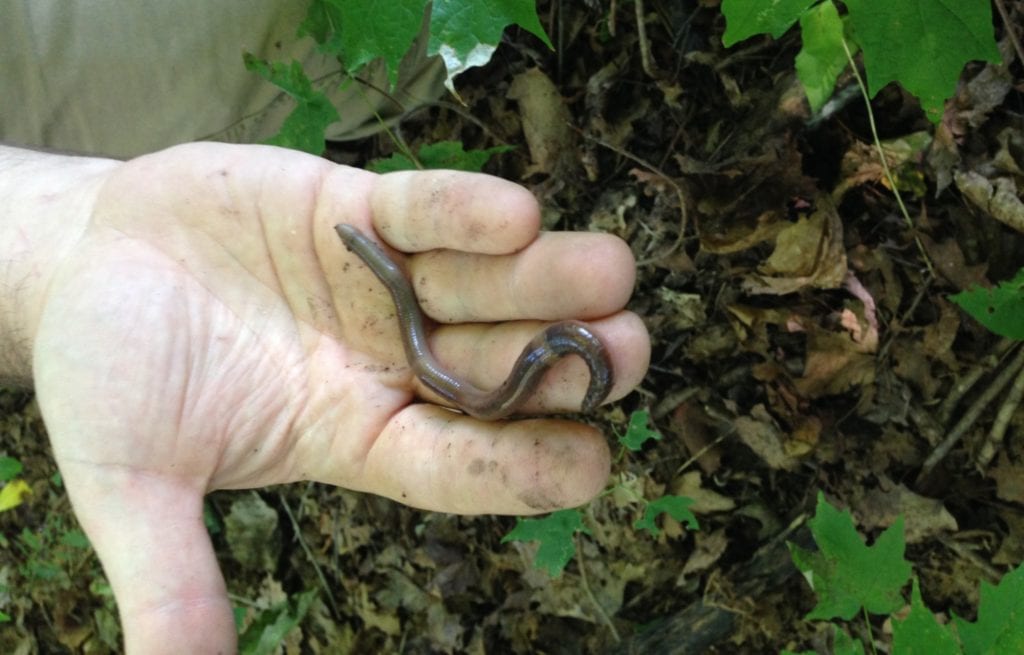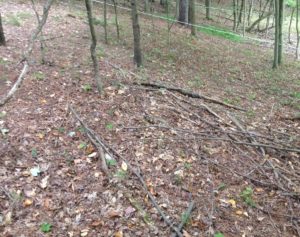by Emma Ehrler
Conventional wisdom tells us that earthworms are good for the soil. They improve soil drainage and aeration, increase nutrient availability, and enhance soil structure. While this may be true of some earthworm species, a family of more recently introduced earthworms are changing how we look at worms in the environment. Jumping worms (Amynthas spp.), also known as snake worms or crazy worms, are an invasive earthworm introduced to North America from eastern Asia. In short: they have the potential to dramatically change soil structure, impact forest ecology, and reduce biodiversity.

What Damage Do They Cause?
Jumping worms alter soil structure more than any other worm. They are voracious, devouring the organic layer of the soil and leaving behind abundant coffee ground-like castings. Unlike other earthworms, jumping worms live and feed close to the soil surface. In woodland areas, they can quickly consume all of the leaf litter on the forest floor and make the upper layers of the soil feel grainy with their castings. While this change to the soil structure may not have a major effect on cultivated bedding plants, it can be extremely detrimental to native plants and animals.

A forest floor showing evidence of jumping worms. Photo courtesy of UVM.
Most earthworms in the northeast are considered exotic. They were introduced to North America in the 18th and 19th centuries from Europe and Asia through the trade of horticultural materials. Native plants in the northeast evolved without the presence of earthworms, and Northeastern forests have a characteristically thick layer of leaf litter and organic matter. Many native plants require this organic layer for their seeds to germinate. When jumping worms consume the upper organic layer of the soil, native plants slowly disappear, and invasive species take their place. As the forest floor structure changes, other species suffer too, such as ground nesting birds, amphibians, and invertebrates.
How can I tell if it’s a jumping worm?
While the extent of the jumping worm population is still unknown in New Hampshire, where I work, these worms may be found residing in gardens in some parts of the state. Jumping worms are brown to grayish in color with a smooth, white band (clitellum) that completely encircles the body near the head. Unfortunately, jumping worms are very difficult to identify by sight alone. However, their behavior is distinctive. Jumping worms tend to have firm bodies and writhe powerfully if you try to pick them up. They will occasionally lose their tails as a defense mechanism to escape predators. Jumping worms are also remarkably fast, which is how they get their name. Many gardeners (myself included) have been startled by how quickly these worms move, in an almost snake-like fashion, across the soil surface.
You’ll most likely find jumping worms in the garden, compost pile, or adjacent woodlands. They’re surface dwellers that tend to stay in the upper few inches of the soil. A marked reduction in the amount of leaf litter on the forest floor or rapidly disappearing garden mulches are indications that jumping worms are present. In fact, the most significant negative impact these invaders seem to have on gardens is their rapid consumption of mulch. Even woodchips don’t last long when jumping worms are around. If you suspect there may be jumping worms in your garden, digging into the soil should provide the answer. You’ll notice their grainy castings and probably find a worm or two rapidly trying to slither away.
Start looking for adult jumping worms in June. While the adults do not survive the winter, their young persist in cocoons and reach adulthood in mid-summer.
What can you do?
Jumping worms naturally expand their range very slowly. Do not buy or sell mulch, topsoil, compost, or plants that are infested with jumping worms. Before bringing these products home and introducing them to your landscape or garden, carefully inspect the materials for signs of jumping worms and their castings. Be especially careful when sharing plant material at community plant sales and swaps. Jumping worms will readily crawl in to reproduce within nursery pots. If you know you have jumping worms in your garden, it’s better to avoid sharing plants with other gardeners.
Before you purchase any new plants, take a close look at the potting soil. If jumping worms are present, you will see signs of their telltale, coffee-ground like castings on the soil surface. To make sure you aren’t introducing jumping worms with new plantings, try to remove most of the soil from the root ball of a new plant. Knock off the soil into a garbage bin and rinse the roots with water to remove any remaining soil.
Jumping worms are occasionally sold as fishing bait or for use in vermicomposting. Do not purchase them for these purposes or any other purpose and do not release them into the garden.
If you think you have jumping worms in your garden, don’t panic. While you may not be able to eliminate them from your garden, you can still play a big part in preventing their spread. Suspected jumping worm sightings in New Hampshire can be reported to NHBugs or contact your local extension service in your area.
Want to learn more?
If you’re interested in learning more about invasive earthworms check out these resources:
Entomology Research Laboratory at University of Vermont
Jumping Worm Field Guide from the Wisconsin Department of Natural Resources
New York Invasive Species Research Institute
About the Author
Emma Erler is the Education Center Program Coordinator for the University of New Hampshire Extension program. Emma comes to Extension with a strong background in public horticulture, including internships at Longwood Gardens and the Morris Arboretum, both in Pennsylvania. She most recently worked as a gardener at Tower Hill Botanic Garden in Boylston, Massachusetts, where she focused on maintaining the Systematic garden and tending the native plant collection and natural lands. Prior to that, Emma worked as a horticulturist at Heritage Museums & Gardens in Sandwich, Mass., constructing and caring for the Cape Cod Hydrangea Garden, and preserving the historic Dexter Rhododendron collection. Emma is also a long-time volunteer with the Squam Lakes Natural Science Center in Holderness. She received her Bachelor of Science in Environmental Horticulture from the University of New Hampshire.

